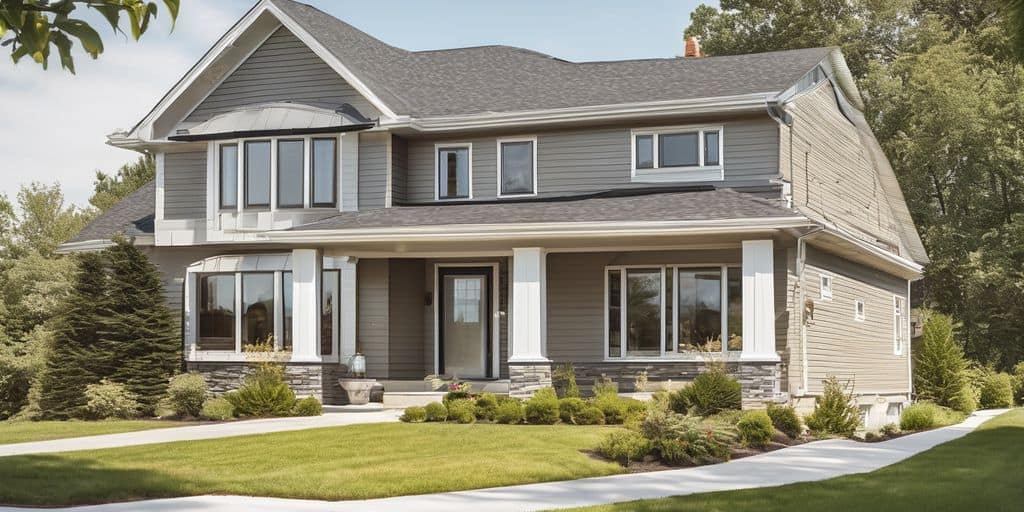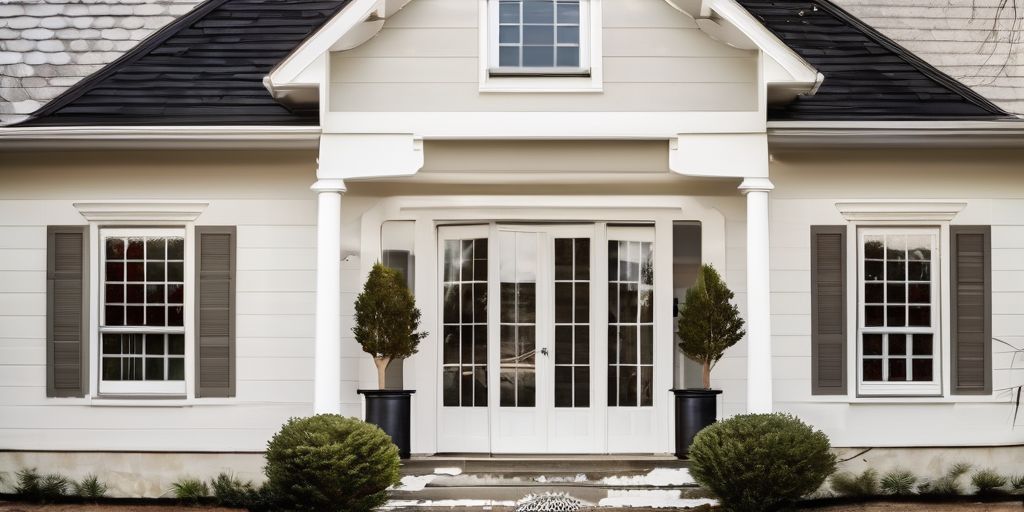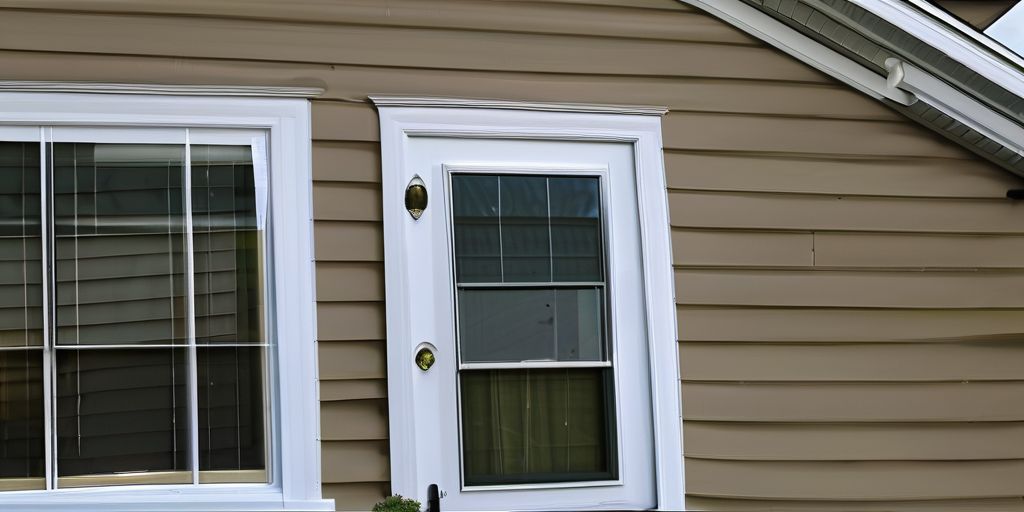Painting vinyl siding in St. Catharines needs special care because of the area’s changing weather. From cold winters with snow and ice to hot summers, picking the right paint and prepping the siding are key steps. This guide will help you choose the best paint, prepare your siding, and keep it looking great for years.
Key Takeaways
- Choose a high-quality paint made for vinyl siding to handle temperature changes and UV rays.
- Make sure to clean and prime the siding before painting for better adhesion.
- Repair any damages on the siding to ensure a smooth and lasting paint job.
- Adapt your painting methods to handle both winter cold and summer heat in St. Catharines.
- Regular maintenance like cleaning and touch-ups will keep your painted siding looking fresh.
Choosing the Right Paint for Vinyl Siding
Selecting the right paint for your vinyl siding is crucial for a long-lasting and beautiful finish. Here are some tips to help you make the best choice.
High-Quality Paint Selection
- Choose a high-quality paint specifically designed for vinyl siding. These paints adhere better and are formulated to withstand temperature fluctuations and UV exposure.
- Consider the local climate. St. Catharines winters can be tough, so make sure the paint you select is suitable for the local weather, with the ability to resist freezing temperatures and snow.
Benefits of UV-Resistant Paint
- UV-resistant paints help protect your siding from the sun’s harsh rays, preventing fading and damage.
- These paints maintain their color longer, keeping your home looking fresh and vibrant.
Paints Suitable for Temperature Fluctuations
- Opt for paints that can handle both hot summers and cold winters. This ensures that your siding remains intact and looks great year-round.
- Look for paints with a Light Reflectance Value (LRV) of 56 or lower to prevent heat distortion.
Remember, the right paint can significantly extend the life of your vinyl siding, keeping it vibrant and protected throughout the seasons.
Preparing Your Vinyl Siding for Painting
Cleaning and Priming
Before you start painting, it’s crucial to clean your vinyl siding thoroughly. This removes any dirt, dust, or debris that could prevent the paint from sticking properly. Use a mild detergent and a soft brush to scrub the surface. Rinse well with water and let it dry completely. Applying a high-quality primer is the next step. This helps create a strong foundation for the paint, ensuring better adhesion and a smoother finish.
Repairing Damages
Inspect your siding for any damages, such as cracks or holes. Repairing these issues is essential for a flawless paint job. For small holes, you can use caulk to fill them in. Let the caulk dry, then trim any excess and sand it smooth. This step is vital for ensuring proper adhesion of the paint.
Ensuring Proper Adhesion
To make sure your paint sticks well, follow these tips:
- Clean the surface thoroughly.
- Use a high-quality primer.
- Repair any damages before painting.
- Choose paint designed for vinyl siding.
Remember, adapting outdoor vinyl siding painting to Niagara Falls’ climate requires careful consideration of seasonal weather patterns and regular maintenance for longevity and durability. Selecting materials and contractors suited to the local climate is crucial.
Adapting to St. Catharines’ Seasonal Weather
Handling Winter Conditions
Winter in St. Catharines can be quite harsh, so it’s important to prepare your vinyl siding for the cold. Here are some tips:
- Conduct seasonal inspections to check for any damage or wear, especially after harsh winters.
- Clean your siding at least twice a year to prevent buildup of dirt and grime.
- Address any issues promptly to prevent further damage.
Staying warm and comfortable while working outside is crucial. Layering is key; start with a moisture-wicking base layer, add an insulating middle layer, and top it off with a windproof and waterproof outer layer.
Dealing with Summer Heat
Summers in St. Catharines can be hot and humid. To ensure your vinyl siding paint lasts through the heat:
- Choose a paint that is UV-resistant to prevent fading.
- Paint during cooler parts of the day, like early morning or late afternoon.
- Ensure proper hydration and take breaks to avoid heat exhaustion.
Weatherproofing Techniques
Weatherproofing your vinyl siding is essential to withstand St. Catharines’ varied climate. Here are some techniques:
- Use high-quality caulk to seal any gaps or cracks.
- Apply a weather-resistant primer before painting.
- Consider adding a protective topcoat for extra durability.
Remember, the climate in St. Catharines and the surrounding Niagara region can be quite similar, so these considerations are broadly applicable across the area. Whether you’re near the iconic Niagara Falls or in a neighboring city, the weather factors play a pivotal role in the maintenance of vinyl siding.
Maintenance Tips for Painted Vinyl Siding
Regular Cleaning
To keep your painted vinyl siding looking fresh, regular cleaning is a must. Use a mild detergent mixed with water and a soft brush to scrub away dirt and grime. Avoid using harsh chemicals as they can damage the paint. Rinse thoroughly with a garden hose.
Inspecting for Wear and Tear
Regularly inspect your siding for any signs of wear and tear. Look for cracks, peeling paint, or any other damage. Early detection can save you from costly repairs down the line. Combating mold and mildew on painted vinyl siding in St. Catharines is crucial for home maintenance.
Touch-Up Painting
Keep some extra paint on hand for touch-ups. This is especially useful for small areas that may get chipped or scratched. Make sure to follow the manufacturer’s instructions for the best results.
Remember, the goal is to maintain your home’s curb appeal while minimizing the need for frequent repainting or extensive repairs.
Common Mistakes to Avoid
When painting your vinyl siding, it’s easy to make mistakes that can lead to poor results or even damage. Here are some common pitfalls to watch out for:
Skipping Primer
Skipping the primer can lead to paint not adhering properly to the vinyl siding. This can cause peeling and flaking over time. Always use a high-quality primer to ensure the paint sticks well.
Using Inappropriate Paint
Choosing the wrong type of paint can make or break your project. Make sure to use paint specifically designed for vinyl siding. This type of paint is more flexible and can handle the expansion and contraction of the vinyl.
Ignoring Weather Forecasts
Painting in the wrong weather conditions can ruin your hard work. Avoid painting on very hot or cold days, and always check the weather forecast. Rain or high humidity can also affect the paint’s ability to dry and adhere properly.
Pro Tip: Always plan your painting project around the weather to ensure the best results.
By avoiding these common mistakes, you can ensure a long-lasting and beautiful finish for your vinyl siding.
Long-Term Benefits of Proper Vinyl Siding Painting
Enhanced Curb Appeal
Painting your vinyl siding can significantly boost your home’s curb appeal. A fresh coat of paint can make your house look new and well-maintained. This is especially important if you live near landmarks like the beautiful Port Dalhousie, where homes are often admired for their charm.
Increased Durability
Using high-quality paint ensures that your vinyl siding will last longer. Durable and long-lasting paint can withstand the elements, from harsh winter conditions to the summer heat. This means fewer touch-ups and less frequent repainting, saving you time and money in the long run.
Cost-Effective Home Maintenance
Properly painted vinyl siding is easier to maintain. Regular cleaning and inspections can help you spot any issues early, preventing costly repairs. Here are some tips to keep your siding looking its best:
- Clean your siding at least once a year.
- Inspect for any signs of wear and tear.
- Perform touch-up painting as needed.
Ensuring the longevity of your painted vinyl siding involves proactive maintenance. Regular cleaning and inspections are key to preserving the vibrant appearance and structural integrity of your siding.
By following these steps, you can enjoy a beautiful, durable, and cost-effective exterior for years to come.
Painting your vinyl siding can offer long-term benefits, such as improved curb appeal and increased home value. A fresh coat of paint not only protects your siding from the elements but also gives your home a new look. Ready to transform your home? Visit our website to learn more about our services and get a free estimate today!
Conclusion
Painting your vinyl siding in St. Catharines requires some extra thought, especially with the local weather. By picking the right paint and following best practices, you can keep your home looking great and protected from the elements. Remember, it’s all about choosing high-quality materials and considering the climate. With a bit of effort, your vinyl siding can stay beautiful and durable for many years. So, take your time, plan well, and enjoy the results of your hard work!
Frequently Asked Questions
What type of paint should I use for vinyl siding?
You should use high-quality paint specifically made for vinyl siding. These paints stick better and can handle changes in temperature and sunlight.
Can I paint vinyl siding in cold weather?
It’s best to avoid painting in very cold weather. Try to paint when the temperature is above 50°F to make sure the paint sticks well.
How do I prepare my vinyl siding before painting?
Start by cleaning the siding well and fixing any damage. Use a good primer to help the paint stick better.
Is UV-resistant paint important for vinyl siding?
Yes, UV-resistant paint helps protect your siding from sun damage, keeping the color looking fresh for longer.
How often should I clean my painted vinyl siding?
You should clean your painted siding at least once a year to remove dirt and keep it looking good.
What are common mistakes to avoid when painting vinyl siding?
Some common mistakes include skipping the primer, using the wrong type of paint, and not checking the weather forecast before starting.




